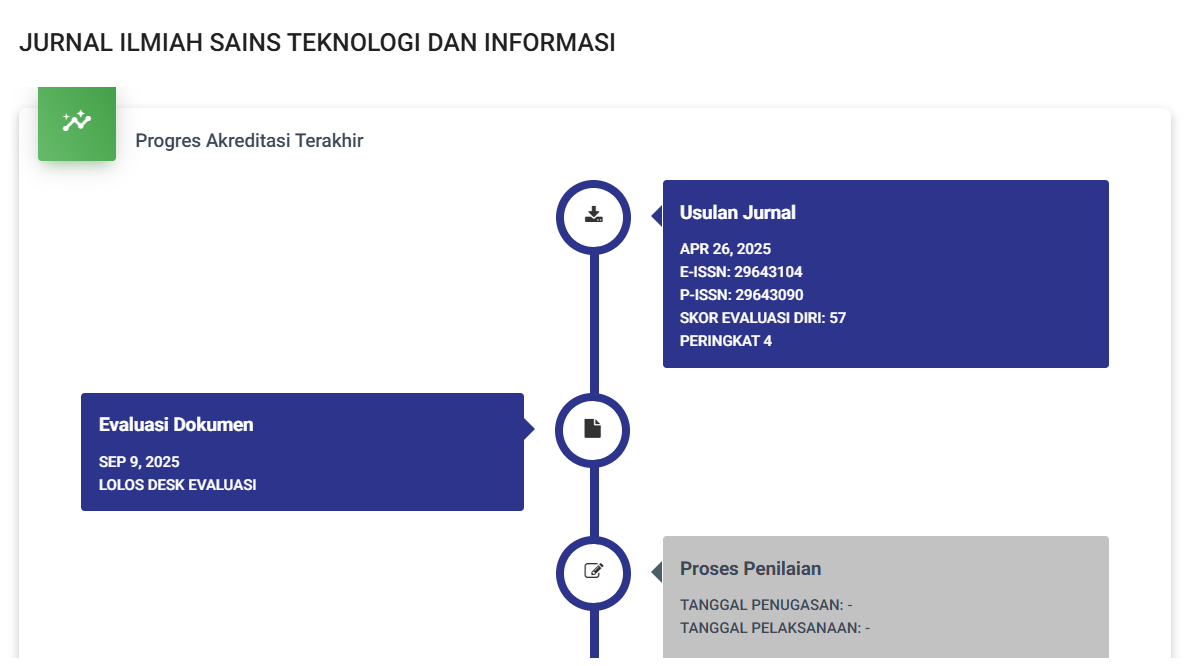Penerapan Decision Trees dalam Mendeteksi Pola Tidur Sehat Berdasarkan Kebiasaan Gaya Hidup
DOI:
https://doi.org/10.59024/jiti.v2i4.969Keywords:
Healthy sleep patterns based on lifestyleAbstract
A good sleep pattern is very important for our body's health both physically and mentally, while lifestyle habits such as physical activity and diet play a big role in influencing sleep quality. By using a decision tree, researchers aim to predict whether we have a healthy sleep pattern or not based on lifestyle. Healthy sleep patterns are regular and quality sleep habits to maintain our physical health. Healthy sleep patterns generally involve sleeping 8 hours – 9 hours per night, having a regular and consistent sleep time. The decision tree model was chosen because of the decision tree's ability to provide accurate predictions and produce rules that are easy to understand. This model can help us raise awareness of the importance of a healthy lifestyle in maintaining sleep quality.
References
M. Hirshkowitz et al., “National Sleep Foundation’s sleep time duration recommendations: methodology and results summary,” Sleep Heal., vol. 1, no. 1, pp. 40–43, 2015, doi: https://doi.org/10.1016/j.sleh.2014.12.010.
S. P. Ahmad Suryadi, Teknologi dan Media Pembelajaran Jilid I. CV Jejak (Jejak Publisher), 2020. [Online]. Available: https://books.google.co.id/books?id=wf30DwAAQBAJ
R. S. Miasari et al., “Teknologi Pendidikan Sebagai Jembatan Reformasi Pembelajaran Di Indonesia Lebih Maju,” J. Manaj. Pendidik. Al Hadi, vol. 2, no. 1, p. 53, 2022, doi: 10.31602/jmpd.v2i1.6390.
Y. Partogi and A. Pasaribu, “Perancangan Metode Decision Tree Terhadap Sistem Perpustakaan STMIK Kuwera,” J. Sist. Inf. dan Teknol., vol. 1, no. 2, pp. 20–25, 2022, doi: 10.56995/sintek.v1i2.4.
A.- Husaini, I. Hariyanti, and A. R. Raharja, “Perbandingan Algoritma Decision Tree dan Naive Bayes dalam Klasifikasi Data Pengaruh Media Sosial dan Jam Tidur Terhadap Prestasi Akademik Siswa,” Technol. J. Ilm., vol. 15, no. 2, p. 332, 2024, doi: 10.31602/tji.v15i2.14381.
N. K. Surbakti, “Data Mining Pengelompokan Pasien Rawat Inap Peserta BPJS Menggunakan Metode Clustering (Studi Kasus : RSU.Bangkatan),” J. Inf. Technol., vol. 1, no. 2, pp. 47–53, 2021, doi: 10.32938/jitu.v1i2.1470.
D. P. Utomo and M. Mesran, “Analisis Komparasi Metode Klasifikasi Data Mining dan Reduksi Atribut Pada Data Set Penyakit Jantung,” J. Media Inform. Budidarma, vol. 4, no. 2, p. 437, 2020, doi: 10.30865/mib.v4i2.2080.
A. H. Nasrullah, “Implementasi Algoritma Decision Tree Untuk Klasifikasi Produk Laris,” J. Ilm. Ilmu Komput., vol. 7, no. 2, pp. 45–51, 2021, doi: 10.35329/jiik.v7i2.203.
Downloads
Published
Issue
Section
License
Copyright (c) 2024 JURNAL ILMIAH SAINS TEKNOLOGI DAN INFORMASI

This work is licensed under a Creative Commons Attribution-ShareAlike 4.0 International License.










